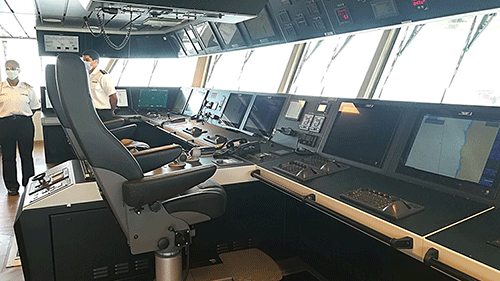The debut of Debmarine Namibia’s N$7 billion state-of-the-art vessel, Benguela Gem, has already increased diamond recovery volumes by 67.2% when compared to production figures from the previous year.
The vessel is expected to contribute approximately N$3 billions a year to the Namibian economy.
According to production updates by De Beers, Namibia was the only country out of four diamond-mining operations with increased production levels.
The Benguela Gem, which began operating at the end of March this year, is currently the world’s largest diamond recovery vessel. The new multi-billion investment is scheduled to operate for at least 30 years and uses sub-sea crawling extraction techniques to retrieve diamonds from the seabed off the coast of Namibia.
The new vessel also incorporates the latest marine technologies that drives improved safety performance while optimising efficiency and utilisation rates.
The unique recovery vessel extracts diamonds off the ocean floor using highly advanced drill technology, supported by sophisticated tracking, positioning and surveying equipment. Debmarine Namibia is internationally certified, in line with its commitment to safety and environmental management, and is a recognised world leader in marine diamond exploration and recovery. The completion and delivery of this vessel earlier this year is the culmination of over six years of planning and was delivered three months ahead of deadline.
Meanwhile, acquiring the Benguela Gem was the largest-ever commercial transactional deal by Debmarine Namibia. The deal, aimed at boosting marine diamond recovery operations, involved five commercial banks partnering on a US$375 million (approximately N$5.6 billion) financing deal to procure the new diamond recovery vessel.
During a recent interview, Debmarine Namibia CFO Willy Mertens, acclaimed the fruition of the Benguela Gem reinforces the company’s commitment to sustainable use of resources for the benefits of all Namibians.
He also highlighted the company’s performance in 2021, with production having been on par with that of 2020, while revenue increased year-on-year, mainly driven by a recovery in the diamond industry after the impacts of Covid-19.
Mertens said the vessel also showcases the company’s continued investment into the future of the diamond industry, with N$6 billion investment in the last three years, which shows its confidence in the outlook of the industry and its aim to deliver value for the company and all Namibian shareholders.
Vessel acquisition
The US$375 million asset financing facility constituted 80% of the vessel cost and which was financed by Absa, Bank Windhoek, Nedbank, FirstRand Bank and Standard Bank Namibia. Debmarine Namibia covered the remaining 20% (N$1.4 billion) of this investment.
The vessel’s build involved many challenges, ranging from the onset of Covid-19 early in the project to the management of many subcontractors, each contributing their specialist skills and products. Engineering challenges included the installation of a DP2
dynamic positioning system based on a
seven-thruster propulsion system powered by six generators, to enable greater flexibility in the vessel’s operations. Project management for the vessel was undertaken by De Beers Marine South Africa.
Debmarine Namibia is a joint venture marine diamond prospecting and recovery company, owned in equal shares by the Namibian government and De Beers Group. Debmarine Namibia began operations in January 2002 and mines off the southern coast of Namibia. The company currently operates five diamond recovery vessels and one exploration and sampling vessel, the MV SS Nujoma.
Locally manufactured parts
In a continuous bid to provide a strong base for domestic economic growth, particularly through the sourcing of local goods and services, Debmarine Namibia sourced parts for the new vessel from around the world and some components were also fabricated locally in Walvis Bay.
According to Debmarine Namibia CEO Otto Shikongo the vessel’s mission equipment was built in the Port of Cape Town concurrently with the construction of the vessel. This equipment consisted of the recovery tool and processing plant, of which parts of the steel works were manufactured in Walvis Bay.
3C Metal Belmet Namibia from Walvis Bay was awarded the contract to fabricate a large number of plates and structures to be installed on the new vessel.
Attesting to the local value addition, managing director of 3C Metal Belmet Namibia Jarcu Groenewald said “the project stretched our capacity as it was a big learning curve for our employees and we are grateful for the opportunity given by Debmarine Namibia”. He added that the project was the biggest awarded to 3C Metal Belmet Namibia to-date, which resulted in an expansion of their facilities and equipment in order to produce quality products. The company is now confident and equipped to take on more advanced projects.
Testing
The Benguela Gem achieved C4 sign-off on 12 February 2022, which was described as a phenomenal achievement a mere three months and 11 days ahead of the approved plan, without recording any safety incidents.
In achieving sign-off, the Benguela Gem performed exceptionally well setting a new record in Atlantic 1 for continuous mining on start-up (73 hrs) and rapid commissioning, operating at full nameplate rates and efficiencies from the start of operations.
Debmarine Namibia conducts marine-based diamond recovery around 120 to 140 metres below sea level with its fleet of six motor vessels (MVs), capable of exploring for and retrieving diamond-bearing materials from the seabed and processing them to a diamond-rich concentrate. The company currently owns, manages, and maintains five diamond recovery vessels and one exploration and sampling vessel, which is a new vessel acquired three years ago, the MV SS Nujoma. The recovery vessels are: MV Mafuta, MV Grand Banks, MV Debmar Pacific, MV Debmar Atlantic and MV !Gariep, all operating in Atlantic 1 mining licence area.


